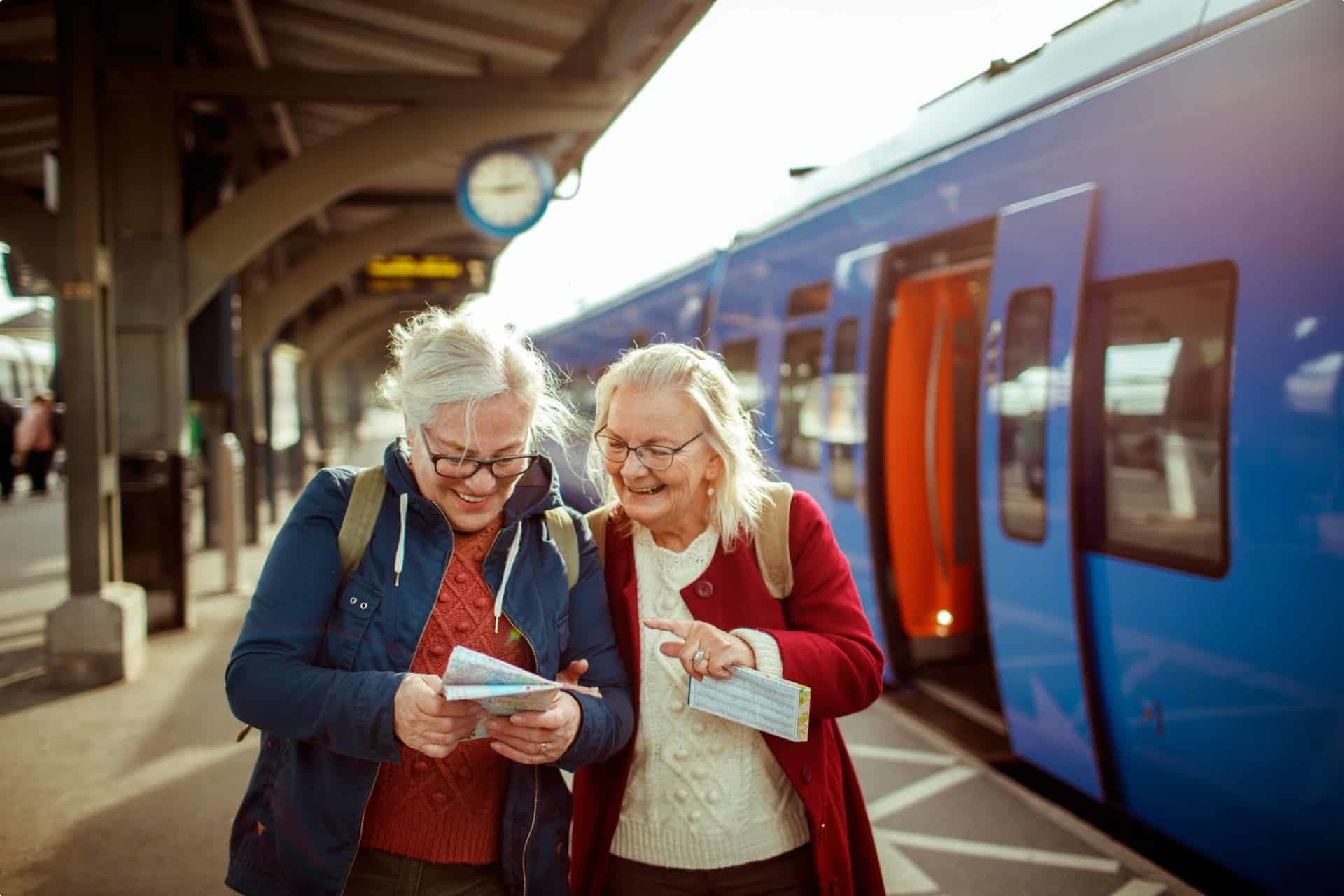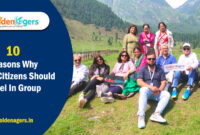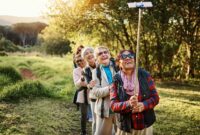Guided tours for seniors offer a unique blend of exploration and relaxation, catering to the specific needs and preferences of this vibrant demographic. This exploration delves into the various tour types, accessibility considerations, marketing strategies, and safety protocols that ensure a memorable and enriching travel experience for older adults. We’ll examine how tour operators can successfully target this market, creating itineraries that balance sightseeing with rest and relaxation while prioritizing safety and inclusivity.
The senior travel market is diverse, encompassing individuals with varying levels of mobility, interests, and budgets. Understanding these nuances is crucial for designing tours that resonate with this audience. From meticulously planned itineraries that prioritize comfort and accessibility to engaging marketing campaigns that highlight the benefits of senior-specific travel, this comprehensive guide provides valuable insights for tour operators and prospective senior travelers alike.
Understanding the Senior Travel Market
The senior travel market represents a significant and growing segment within the tourism industry. Understanding its unique characteristics is crucial for businesses aiming to cater to this demographic effectively. This section will explore the key aspects of this market, focusing on demographics, popular destinations, influential factors, and successful marketing strategies.
Senior Travel Demographics
The senior travel demographic is characterized by a diverse range of individuals, typically aged 55 and above, with varying levels of income, health, and mobility. However, some common threads exist. Many seniors possess significant disposable income accumulated throughout their working lives, enabling them to invest in travel experiences. This group also often values comfort, convenience, and personalized service, seeking stress-free and enriching travel experiences. Furthermore, the increasing health consciousness among seniors influences their travel choices, with a growing preference for accessible destinations and activities. The rise of “active aging” further fuels this trend, with many seniors seeking adventurous and engaging travel options.
Popular Senior Travel Destinations
Senior travelers frequently choose destinations that offer a blend of relaxation, cultural experiences, and accessibility. Popular choices include destinations known for their mild climates, such as Florida, Arizona, and California in the United States; coastal regions in Europe like the Mediterranean; and destinations in Southeast Asia offering a mix of culture and affordability. Cruises are also incredibly popular, providing a convenient and all-inclusive travel option with easy accessibility and onboard amenities. Specific destinations may vary based on individual preferences and budgets, but a common thread is the prioritization of comfort, ease of access, and enriching experiences.
Factors Influencing Senior Travel Choices
Several key factors significantly influence senior travel choices. Budget plays a crucial role, with many seniors seeking value for money and comparing prices across various options. Health and mobility are also critical considerations, with seniors prioritizing destinations and accommodations that cater to their physical limitations. Accessible transportation, readily available medical services, and well-maintained facilities are often top priorities. Finally, individual interests heavily influence destination selection, with some seniors preferring cultural tours, others opting for relaxing beach vacations, and still others seeking adventurous activities. A successful travel plan caters to all these interwoven factors.
Successful Marketing Campaigns Targeting Seniors
Effective marketing campaigns targeting seniors emphasize clarity, ease of understanding, and a focus on the value and benefits offered. Successful strategies often use large, clear fonts, simple language, and visuals that resonate with the target audience. Highlighting accessibility features, emphasizing stress-free travel, and showcasing positive experiences are also crucial. For example, a cruise line might emphasize the convenience of all-inclusive packages and onboard amenities, while a tour operator might highlight accessible transportation and itineraries catering to specific interests, such as history or nature. Emphasizing social interaction and opportunities to connect with others during travel can also be a powerful marketing tool. Using testimonials from satisfied senior travelers adds credibility and builds trust.
Types of Guided Tours for Seniors
Choosing the right guided tour is crucial for a positive and enjoyable senior travel experience. The ideal tour will depend on individual preferences, physical capabilities, and interests. Several tour types cater specifically to the needs and desires of older travelers, offering varying levels of activity and accessibility.
Tour Types and Their Suitability for Seniors
Different tour types offer unique advantages and disadvantages for senior travelers. Careful consideration of these factors ensures a comfortable and memorable journey.
Walking Tours
Walking tours provide an intimate experience, allowing for close observation of historical sites, local neighborhoods, and cultural landmarks. However, they require a reasonable level of physical fitness and stamina. Paved surfaces and manageable distances are crucial for accessibility.
Bus Tours
Bus tours offer a convenient and comfortable way to cover larger distances and see multiple attractions in a single day. They minimize physical exertion, making them ideal for seniors with mobility limitations. However, the experience can be less immersive than walking tours, and the itinerary may be less flexible.
Cruises
Cruises combine travel, accommodation, and entertainment into one package. They offer a relaxing and luxurious experience, with accessible amenities and onboard activities catering to various interests. However, cruises can be expensive and may involve a lot of walking within the ship itself, even if shore excursions are minimal.
Adventure Tours
Adventure tours, while potentially exciting, often require a higher level of physical fitness and may not be suitable for all seniors. These tours can involve strenuous activities like hiking, kayaking, or wildlife safaris. However, some adventure tours offer modified itineraries or activities to accommodate senior participants with varying levels of physical capabilities. For example, a guided nature walk on mostly flat terrain could be considered a gentler form of adventure tourism.
Comparison of Tour Types
| Tour Type | Physical Exertion | Cost | Accessibility |
|---|---|---|---|
| Walking Tour | Moderate to High | Moderate | Moderate (depends on route and terrain) |
| Bus Tour | Low | Moderate to High | High |
| Cruise | Low to Moderate | High | High (generally) |
| Adventure Tour | High | High | Low to Moderate (depends on the specific tour) |
Specialized Tours for Senior Interests
Many tour operators offer specialized tours catering to specific senior interests. These tours often provide a more focused and engaging experience, enhancing the overall travel enjoyment.
History Tours
History buffs can explore historical sites, museums, and battlefields, delving deeper into specific historical periods or events. These tours often include guided commentary by expert historians. Examples include tours of ancient Roman ruins or Civil War battlefields, tailored to the interests and pace of senior travelers.
Nature Tours
Nature tours offer opportunities to explore national parks, botanical gardens, and wildlife reserves. These tours often involve moderate walking, bird watching, or wildlife viewing, with transportation provided between locations. An example would be a guided tour of Yellowstone National Park, focusing on accessible viewing points and comfortable transportation.
Art Tours
Art enthusiasts can enjoy guided tours of art museums, galleries, and studios, learning about renowned artists and art movements. These tours often include insightful commentary from art historians or curators. Examples include tours of the Louvre Museum in Paris or the Metropolitan Museum of Art in New York City, designed to accommodate senior participants’ physical needs.
Accessibility and Inclusivity in Senior Tours
Creating truly enjoyable and memorable travel experiences for seniors necessitates a thoughtful approach to accessibility and inclusivity. Failing to consider the diverse needs of older travelers can significantly detract from their overall experience and even present safety concerns. Designing tours with accessibility in mind not only ensures a comfortable journey for all participants but also fosters a sense of belonging and respect.
Accessibility features are paramount in tour design for seniors with varying mobility levels. This encompasses a wide range of considerations, from the physical environment to the pace and structure of the itinerary. The goal is to eliminate barriers that might prevent participation and ensure that everyone can engage fully in the tour activities.
Assistive Devices and Support Services
The effective utilization of assistive devices and the availability of support services are crucial for ensuring a positive and safe experience for seniors with mobility challenges. Assistive devices such as wheelchairs, walkers, and hearing aids should be accommodated throughout the tour. This includes ensuring easy access to restrooms, transportation, and tour sites, as well as providing appropriate assistance with boarding and disembarking vehicles. Support services, such as trained personnel to assist with mobility or communication, should be readily available to address individual needs. For instance, a tour operator might partner with a local agency specializing in senior care to provide on-site assistance, or they might include a dedicated support staff member as part of the tour team. The availability of such services should be clearly communicated to potential travelers in advance.
Accessibility Checklist for Tour Operators
A comprehensive checklist ensures inclusivity for all seniors. Before designing and operating a tour, operators should review the following key aspects:
- Transportation: Are vehicles wheelchair accessible? Is there sufficient space for walkers and other mobility aids? Is there assistance available for boarding and disembarking?
- Accommodation: Are hotels and lodgings accessible? Do they offer accessible rooms with features like roll-in showers and grab bars?
- Tour Sites: Are all sites accessible, or are there alternative arrangements for those with limited mobility? Are there ramps, elevators, and accessible restrooms?
- Itinerary: Is the pace of the itinerary manageable for seniors? Are there sufficient rest stops and opportunities for breaks?
- Communication: Is information provided in accessible formats, such as large print or audio versions? Are tour guides trained to communicate clearly and effectively with seniors who may have hearing impairments?
- Emergency Preparedness: Are there clear emergency procedures in place? Is there readily available medical assistance?
Examples of Inclusive Tour Practices
Several tour operators are implementing innovative practices to promote inclusivity. For example, some companies offer tours specifically designed for seniors with varying levels of mobility, featuring slower paces, shorter walking distances, and more frequent rest breaks. Others incorporate assistive technology, such as audio descriptions for visually impaired travelers or real-time captioning for those with hearing difficulties. Furthermore, some tours proactively engage with local communities to ensure that all sites and activities are accessible and welcoming to seniors with diverse needs. A successful example would be a tour that utilizes accessible transportation and incorporates visits to museums with dedicated wheelchair ramps and audio guides. This holistic approach creates a positive experience for all participants.
Marketing and Promotion of Senior Tours
Marketing senior tours requires a nuanced approach, understanding the specific needs and preferences of this demographic. Success hinges on effectively communicating the value proposition – ease, comfort, and enriching experiences – while building trust and credibility. This involves choosing the right channels, crafting compelling messaging, and leveraging social proof.
Effective marketing strategies for senior tours should prioritize clear, concise communication and readily accessible information. Seniors often appreciate a straightforward, no-nonsense approach, and marketing materials should reflect this preference.
Marketing Channels for Senior Tours
Reaching the senior travel market effectively requires a multi-channel approach. While online presence is crucial, print media still holds significant value within this demographic.
- Print Media: Senior-focused publications, travel magazines, and community newspapers offer targeted advertising opportunities. Well-designed brochures with large, clear fonts and high-quality photography are essential. Consider partnerships with retirement communities and senior centers for brochure distribution.
- Online Platforms: A user-friendly website with detailed tour information, high-resolution images, and accessible booking options is paramount. Search engine optimization (SEO) is vital to ensure visibility on search engines like Google. Online travel agencies (OTAs) specializing in senior travel can also be valuable partners.
- Social Media: Platforms like Facebook and Instagram, while often associated with younger audiences, can be effective when used strategically. Focus on visually appealing content, showcasing the tour experiences and highlighting positive testimonials. Targeted advertising campaigns can further refine reach.
- Email Marketing: Building an email list allows for direct communication with potential customers. Regular newsletters featuring tour updates, special offers, and travel tips can nurture leads and build relationships.
Sample Marketing Materials
Marketing materials should emphasize the ease and comfort of senior-specific tours. They should clearly communicate accessibility features, emphasize smaller group sizes for personalized attention, and showcase the unique experiences offered.
Website Content Example: The website homepage could feature a large, high-quality image of seniors enjoying a tour activity, accompanied by a headline such as “Effortless Exploration: Guided Tours Designed for Seniors.” The website should clearly outline tour itineraries, pricing, accessibility features, and testimonials.
Brochure Example: A brochure could use large, easy-to-read fonts and high-quality photographs showcasing scenic locations and happy seniors engaging in tour activities. The brochure should highlight key selling points such as comfortable transportation, accessible accommodations, and experienced tour guides. It should also include a clear call to action, such as a website address or phone number.
Utilizing Testimonials and Case Studies
Testimonials and case studies build trust and credibility by providing social proof. These demonstrate the positive experiences of previous participants, addressing potential concerns seniors might have about traveling.
Testimonial Example: “I was hesitant to travel alone at my age, but this tour was truly wonderful. The pace was perfect, the accommodations were comfortable, and our guide was so knowledgeable and helpful. I highly recommend it!” – Mary S., 72.
Case Study Example: A case study could highlight a specific tour, showcasing its itinerary, accessibility features, and positive feedback from participants. It could include before-and-after photos, illustrating the transformative experience of the tour. For example, a case study could detail a tour to a national park, highlighting the accessible pathways, comfortable transportation, and the positive impact the trip had on participants’ health and well-being.
Tour Itinerary Design for Seniors
Crafting a well-designed itinerary is paramount for a successful senior-focused guided tour. It’s about creating an experience that is both enriching and comfortable, balancing sightseeing with ample opportunities for rest and rejuvenation. A thoughtfully planned itinerary ensures participants feel engaged, not overwhelmed, allowing them to fully appreciate the journey.
Effective itinerary design for senior travelers requires careful consideration of several key elements. These elements work together to create a positive and memorable travel experience, mitigating potential fatigue and maximizing enjoyment. The key is to strike a balance between activity and relaxation, ensuring the tour is both stimulating and comfortable for all participants.
Daily Schedule Examples: Balancing Sightseeing and Rest
Sample daily schedules should incorporate a mix of structured activities and free time, allowing seniors to explore at their own pace and manage their energy levels effectively. This approach respects the diverse needs and preferences within a group. Consider these examples:
Example 1: A Relaxed Pace Itinerary
Morning: Gentle walking tour of a historical district (2 hours), followed by a leisurely brunch at a local café (1 hour).
Afternoon: Free time for relaxation or optional afternoon tea at a charming hotel (2 hours).
Evening: Dinner at a restaurant with live music (2 hours).
Example 2: A More Active Itinerary (with built-in flexibility)
Morning: Guided tour of a museum (2 hours), followed by a coffee break (30 minutes).
Afternoon: Visit to a botanical garden with rest stops along the way (2 hours), followed by free time for shopping or relaxing at the hotel (2 hours).
Evening: Optional group dinner or free time for individual dining.
The Importance of Pacing and Flexibility in Tour Itineraries
Pacing is crucial. Seniors may have different physical capabilities and stamina levels. A well-designed itinerary incorporates ample time for rest and avoids overly ambitious daily schedules. Flexibility is equally vital. Unexpected delays or changes in weather conditions may occur. The itinerary should allow for adjustments to accommodate these unforeseen circumstances. Building in buffer time between activities helps prevent rushing and stress.
Incorporating Appropriate Breaks and Downtime into a Multi-Day Tour
Downtime is not a luxury; it’s a necessity for a successful senior tour. It allows participants to recharge, process their experiences, and maintain their energy levels throughout the trip. This can be achieved through various means.
Strategies for Incorporating Breaks and Downtime:
- Scheduled breaks throughout the day: Short breaks every couple of hours, allowing for rest and refreshment. These could be simple coffee breaks, short rests in a park, or a chance to sit and people-watch.
- Longer periods of free time: Incorporate at least one full afternoon or morning of free time each day, allowing seniors to pursue their interests at their own pace.
- Rest days: Include a full day of rest every few days of sightseeing. This provides ample time to relax, recover, and prepare for further adventures.
- Optional activities: Offer a range of activities with varying levels of intensity, allowing seniors to choose what suits their energy levels on any given day.
- Transportation considerations: Choose transportation methods that are comfortable and minimize travel time, such as private coaches with comfortable seating and ample legroom. Avoid overly long bus rides or transfers.
Safety and Security Considerations
Prioritizing the safety and well-being of senior travelers is paramount when organizing and conducting guided tours. A proactive approach to risk management, coupled with clear communication and well-defined procedures, ensures a secure and enjoyable experience for all participants. This section outlines key safety considerations, the tour guide’s crucial role, emergency protocols, and the importance of protective measures.
Potential Safety Concerns and Mitigation Strategies
Several factors can pose safety risks to senior travelers. These include falls, medical emergencies, getting lost, theft, and exposure to extreme weather conditions. Mitigation strategies involve careful trip planning, selecting accessible accommodations and transportation, providing clear and frequent communication, and employing well-trained guides. For instance, choosing hotels with elevators and easily accessible rooms minimizes fall risks for those with mobility issues. Regular check-ins with participants help prevent individuals from getting lost, while providing readily available contact information for emergencies and pre-arranging transportation for individuals with limited mobility ensures their safe transit. Thorough risk assessments, considering the specific destinations and activities planned, allow for proactive measures to be implemented. For example, in areas prone to extreme heat, schedules should incorporate rest periods and access to hydration and shade.
The Tour Guide’s Role in Ensuring Safety and Well-being
The tour guide plays a vital role in maintaining the safety and well-being of senior travelers. They act as a primary point of contact, providing assistance, monitoring participants’ health, and responding to emergencies. This includes being aware of individual participant needs, offering support with mobility challenges, and ensuring participants remain hydrated and comfortable throughout the tour. Guides should also be adept at identifying potential hazards and taking preventative measures, such as alerting participants to slippery surfaces or uneven terrain. Moreover, regular communication and check-ins with participants are essential, ensuring that any concerns or difficulties are addressed promptly. First aid and CPR training is also highly recommended for tour guides handling senior groups.
Emergency Procedures and Contact Information for Tour Operators
Establishing clear emergency procedures is crucial for a smooth response to unforeseen events. This should include a readily available list of emergency contacts: local emergency services (police, ambulance, fire department), a designated contact person within the tour company, and relevant medical facilities. The procedures should outline steps to be taken in various scenarios, such as medical emergencies, accidents, or severe weather events. This information should be communicated clearly to participants before and during the tour, and readily available in written form. For example, a laminated card containing key emergency numbers and contact information can be provided to each participant. A detailed emergency plan should also be communicated to the entire team, including drivers and any other support staff.
The Importance of Travel Insurance and Other Protective Measures
Comprehensive travel insurance is highly recommended for senior travelers. It provides financial protection against unforeseen circumstances such as medical emergencies, trip cancellations, or lost luggage. Policies should cover medical expenses, emergency evacuation, and repatriation. In addition to travel insurance, other protective measures include providing participants with a detailed itinerary, including emergency contact information, and encouraging them to carry personal identification, such as a medical alert bracelet. Participants should be advised to inform their families or friends about their travel plans and expected return date. Furthermore, using secure transportation services and advising participants about personal safety precautions, such as being aware of their surroundings and avoiding walking alone at night, are essential preventative measures.
Visual Representation of a Senior Tour
Visual representations are crucial in marketing and promoting senior tours. They should evoke feelings of comfort, joy, and engagement, accurately reflecting the experience offered. Two contrasting yet complementary scenes effectively showcase the appeal of senior-focused travel.
Scene One: The Tuscan Sunset
Imagine a sun-drenched Tuscan vineyard, bathed in the warm glow of a late afternoon sun. The light, a soft golden hue, casts long shadows across the rows of neatly pruned vines. The air is filled with the scent of ripe grapes and the gentle hum of bees. A group of seniors, dressed in comfortable clothing, are seated at long, rustic wooden tables, enjoying a leisurely wine tasting. Their faces are alight with smiles and animated conversation; laughter rings out, mingling with the clinking of glasses. The scene is vibrant yet peaceful, emphasizing the relaxed and enjoyable atmosphere of the tour. Rich earth tones of the vineyard are complemented by the bright colors of the wine glasses and the cheerful clothing of the participants. The overall mood is one of contentment and camaraderie, conveying a sense of shared experience and joyful exploration.
Scene Two: Engaging with the Local Guide
The scene shifts to a charming, cobblestone piazza in a picturesque Italian town. A knowledgeable tour guide, with a warm and approachable demeanor, is gesturing enthusiastically as he explains the history of a nearby fountain. He stands slightly lower than the seated seniors, maintaining eye contact and a friendly posture. His body language is open and inviting, fostering a sense of connection. The seniors lean forward attentively, their expressions reflecting curiosity and engagement. Some are taking notes, others are asking questions, and all are actively participating in the discussion. The lighting is natural and bright, enhancing the vibrancy of the scene. The guide’s smile is genuine, mirroring the enthusiasm of the participants. The overall atmosphere is one of lively intellectual exchange and genuine human connection, demonstrating the value of personalized attention and expert guidance in senior travel.
Last Recap
Ultimately, the success of guided tours for seniors hinges on a thoughtful and comprehensive approach that prioritizes accessibility, safety, and the unique interests of the target demographic. By carefully considering factors such as mobility, budget, and personal preferences, tour operators can create enriching travel experiences that empower seniors to explore the world with confidence and joy. The focus on inclusivity and personalized service ensures that every participant has a positive and memorable journey, fostering a sense of community and shared adventure.




